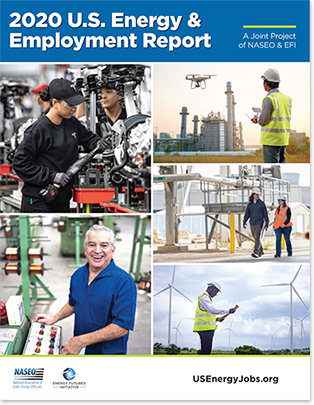Newly Released US Energy and Employment REport Underscores Hiring Challenges Faced by CEWD Members
The 2020 US Energy and Employment Report (USEER), released today, highlights the difficulty many in the energy industry face trying to hire skilled workers. This issue remains at the core of CEWD’s mission to fuel a skilled energy workforce pipeline to meet future industry needs.
According to data in the report, the challenge persisted across all sectors in 2019, with 84 percent of energy employers reporting difficulty hiring qualified workers. This represents an increase of 7 percentage points from the year prior and 14 percentage points since 2017, underscoring the pervasiveness of the problem.
Across sectors, employers listed a lack of experience, training, or technical skills as the top reasons it was difficult to hire needed workers. The need for technical training and certifications were also cited, “implying the need for expanded investments in workforce training and closer coordination between employers and the workforce training system,” according to the report.
These findings align with concerns frequently voiced by CEWD members, with the priorities our organization has set and with the work it has been doing since its inception. While we have unquestionably made progress, there is clearly more work to be done.
“When CEWD was first started, 50 percent of the utility workforce was eligible to retire in the next five years. We had no steady stream of talent for specific skillsets. Our goal was to identify critical jobs, determine the best way to recruit and train, and then develop pipelines,” said CEWD Executive Director Missy Henriksen, who is quoted in the report.
Initially through job-training boot camps, and then through a wider range of solutions developed and implemented through CEWD-sponsored state energy workforce consortia, the industry has greatly improved efforts to recruit, train, and retain workers and develop clear energy career pathways for tomorrow’s workers.
“Retirement rates are now on pace with national norms for other industries and business leaders in the energy field no longer predict a mass attrition bubble. The industry’s biggest workforce issue today is skills,” the report quotes Henriksen as saying. She notes that infrastructure modernization and a change in generation mix contribute to the need for new skills, which also include critical thinking, problem solving, and “the ability to thrive in team environments. A whole transformation of the industry is taking place that will require a higher level of skills that, in turn, are adaptable to future needs.”
Toward this end, CEWD’s Workforce Development Executive Council and Board of Directors have identified a set of external goals and are building out a three-year plan to support initiatives in each of these areas. The goals include: launching public relations initiatives to make the industry relevant to future professionals; forging partnerships and launching programs to fuel workforce diversity; and offering best practice dialogues around training and upskilling workers.
“CEWD will continue to support its members with toolkits, consultancy support, and other resources to aid in workforce development efforts, but will begin taking on a more assertive role in harnessing the power of the industry to expand its external workforce development efforts,” said Henriksen.
“For example, we are participating in a pilot program with DOL to connect transitioning service members and their spouses into industry-focused apprenticeships,” Henriksen noted. She elaborated, stating, “CEWD is exploring engagement with the President’s Pledge for America’s Workers and creating national connections with the workforce board systems and grass top organizations that support communities across the country; we will be introducing best workforce development practices from other industries into energy sector conversations.”

